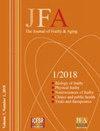Challenges in the Development of Drugs for Sarcopenia and Frailty - Report from the International Conference on Frailty and Sarcopenia Research (ICFSR) Task Force
IF 3.3
Q2 GERIATRICS & GERONTOLOGY
引用次数: 7
Abstract
Sarcopenia and frailty represent two burdensome conditions, contributing to a broad spectrum of adverse outcomes. The International Conference on Frailty and Sarcopenia Research (ICFSR) Task Force met virtually in September 2021 to discuss the challenges in the development of drugs for sarcopenia and frailty. Lifestyle interventions are the current mainstay of treatment options in the prevention and management of both conditions. However, pharmacological agents are needed for people who do not respond to lifestyle modifications, for those who are unable to adhere, or for whom such interventions are inaccessible/unfeasible. Preliminary results of ongoing trials were presented and discussed. Several pharmacological candidates are currently under clinical evaluation with promising early results, but none have been approved for either frailty or sarcopenia. The COVID-19 pandemic has reshaped how clinical trials are conducted, in particular by enhancing the usefulness of remote technologies and assessments/interventions.肌少症和虚弱药物开发的挑战-来自国际会议的报告虚弱和肌少症研究(ICFSR)工作组
肌肉无力和虚弱是两种负担沉重的情况,导致了广泛的不良后果。国际虚弱和肌肉减少症研究会议(ICFSR)工作组于2021年9月举行了实质性会议,讨论了开发治疗肌肉减少症和虚弱的药物方面的挑战。生活方式干预是目前预防和管理这两种疾病的主要治疗选择。然而,对于那些对生活方式改变没有反应的人,对于那些无法坚持的人,或者对于那些无法进行/不可行这种干预的人,需要药物制剂。介绍并讨论了正在进行的试验的初步结果。一些候选药物目前正在进行临床评估,早期结果很有希望,但没有一种被批准用于治疗虚弱或少肌症。新冠肺炎大流行改变了临床试验的进行方式,特别是通过提高远程技术和评估/干预措施的实用性。
本文章由计算机程序翻译,如有差异,请以英文原文为准。
求助全文
约1分钟内获得全文
求助全文
来源期刊

Journal of Frailty & Aging
GERIATRICS & GERONTOLOGY-
CiteScore
5.90
自引率
7.70%
发文量
54
期刊介绍:
The Journal of Frailty & Aging is a peer-reviewed international journal aimed at presenting articles that are related to research in the area of aging and age-related (sub)clinical conditions. In particular, the journal publishes high-quality papers describing and discussing social, biological, and clinical features underlying the onset and development of frailty in older persons. The Journal of Frailty & Aging is composed by five different sections: - Biology of frailty and aging In this section, the journal presents reports from preclinical studies and experiences focused at identifying, describing, and understanding the subclinical pathophysiological mechanisms at the basis of frailty and aging. - Physical frailty and age-related body composition modifications Studies exploring the physical and functional components of frailty are contained in this section. Moreover, since body composition plays a major role in determining physical frailty and, at the same time, represents the most evident feature of the aging process, special attention is given to studies focused on sarcopenia and obesity at older age. - Neurosciences of frailty and aging The section presents results from studies exploring the cognitive and neurological aspects of frailty and age-related conditions. In particular, papers on neurodegenerative conditions of advanced age are welcomed. - Frailty and aging in clinical practice and public health This journal’s section is devoted at presenting studies on clinical issues of frailty and age-related conditions. This multidisciplinary section particularly welcomes reports from clinicians coming from different backgrounds and specialties dealing with the heterogeneous clinical manifestations of advanced age. Moreover, this part of the journal also contains reports on frailty- and age-related social and public health issues. - Clinical trials and therapeutics This final section contains all the manuscripts presenting data on (pharmacological and non-pharmacological) interventions aimed at preventing, delaying, or treating frailty and age-related conditions.The Journal of Frailty & Aging is a quarterly publication of original papers, review articles, case reports, controversies, letters to the Editor, and book reviews. Manuscripts will be evaluated by the editorial staff and, if suitable, by expert reviewers assigned by the editors. The journal particularly welcomes papers by researchers from different backgrounds and specialities who may want to share their views and experiences on the common themes of frailty and aging.The abstracting and indexing of the Journal of Frailty & Aging is covered by MEDLINE (approval by the National Library of Medicine in February 2016).
 求助内容:
求助内容: 应助结果提醒方式:
应助结果提醒方式:


